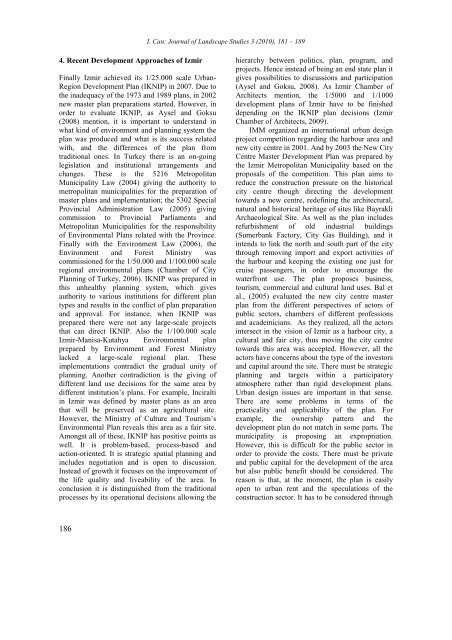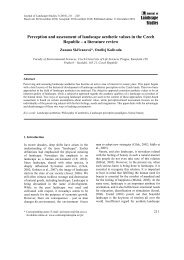Urban Design and the Planning System in Izmir - Centrum pro krajinu
Urban Design and the Planning System in Izmir - Centrum pro krajinu
Urban Design and the Planning System in Izmir - Centrum pro krajinu
Create successful ePaper yourself
Turn your PDF publications into a flip-book with our unique Google optimized e-Paper software.
I. Can: Journal of L<strong>and</strong>scape Studies 3 (2010), 181 – 189<br />
4. Recent Development Ap<strong>pro</strong>aches of <strong>Izmir</strong><br />
F<strong>in</strong>ally <strong>Izmir</strong> achieved its 1/25.000 scale <strong>Urban</strong>-<br />
Region Development Plan (IKNIP) <strong>in</strong> 2007. Due to<br />
<strong>the</strong> <strong>in</strong>adequacy of <strong>the</strong> 1973 <strong>and</strong> 1989 plans, <strong>in</strong> 2002<br />
new master plan preparations started. However, <strong>in</strong><br />
order to evaluate IKNIP, as Aysel <strong>and</strong> Goksu<br />
(2008) mention, it is important to underst<strong>and</strong> <strong>in</strong><br />
what k<strong>in</strong>d of environment <strong>and</strong> plann<strong>in</strong>g system <strong>the</strong><br />
plan was <strong>pro</strong>duced <strong>and</strong> what is its success related<br />
with, <strong>and</strong> <strong>the</strong> differences of <strong>the</strong> plan from<br />
traditional ones. In Turkey <strong>the</strong>re is an on-go<strong>in</strong>g<br />
legislation <strong>and</strong> <strong>in</strong>stitutional arrangements <strong>and</strong><br />
changes. These is <strong>the</strong> 5216 Metropolitan<br />
Municipality Law (2004) giv<strong>in</strong>g <strong>the</strong> authority to<br />
metropolitan municipalities for <strong>the</strong> preparation of<br />
master plans <strong>and</strong> implementation; <strong>the</strong> 5302 Special<br />
Prov<strong>in</strong>cial Adm<strong>in</strong>istration Law (2005) giv<strong>in</strong>g<br />
commission to Prov<strong>in</strong>cial Parliaments <strong>and</strong><br />
Metropolitan Municipalities for <strong>the</strong> responsibility<br />
of Environmental Plans related with <strong>the</strong> Prov<strong>in</strong>ce.<br />
F<strong>in</strong>ally with <strong>the</strong> Environment Law (2006), <strong>the</strong><br />
Environment <strong>and</strong> Forest M<strong>in</strong>istry was<br />
commissioned for <strong>the</strong> 1/50.000 <strong>and</strong> 1/100.000 scale<br />
regional environmental plans (Chamber of City<br />
<strong>Plann<strong>in</strong>g</strong> of Turkey, 2006). IKNIP was prepared <strong>in</strong><br />
this unhealthy plann<strong>in</strong>g system, which gives<br />
authority to various <strong>in</strong>stitutions for different plan<br />
types <strong>and</strong> results <strong>in</strong> <strong>the</strong> conflict of plan preparation<br />
<strong>and</strong> ap<strong>pro</strong>val. For <strong>in</strong>stance, when IKNIP was<br />
prepared <strong>the</strong>re were not any large-scale <strong>pro</strong>jects<br />
that can direct IKNIP. Also <strong>the</strong> 1/100.000 scale<br />
<strong>Izmir</strong>-Manisa-Kutahya Environmental plan<br />
prepared by Environment <strong>and</strong> Forest M<strong>in</strong>istry<br />
lacked a large-scale regional plan. These<br />
implementations contradict <strong>the</strong> gradual unity of<br />
plann<strong>in</strong>g. Ano<strong>the</strong>r contradiction is <strong>the</strong> giv<strong>in</strong>g of<br />
different l<strong>and</strong> use decisions for <strong>the</strong> same area by<br />
different <strong>in</strong>stitution’s plans. For example, Inciralti<br />
<strong>in</strong> <strong>Izmir</strong> was def<strong>in</strong>ed by master plans as an area<br />
that will be preserved as an agricultural site.<br />
However, <strong>the</strong> M<strong>in</strong>istry of Culture <strong>and</strong> Tourism’s<br />
Environmental Plan reveals this area as a fair site.<br />
Amongst all of <strong>the</strong>se, IKNIP has positive po<strong>in</strong>ts as<br />
well. It is <strong>pro</strong>blem-based, <strong>pro</strong>cess-based <strong>and</strong><br />
action-oriented. It is strategic spatial plann<strong>in</strong>g <strong>and</strong><br />
<strong>in</strong>cludes negotiation <strong>and</strong> is open to discussion.<br />
Instead of growth it focuses on <strong>the</strong> im<strong>pro</strong>vement of<br />
<strong>the</strong> life quality <strong>and</strong> liveability of <strong>the</strong> area. In<br />
conclusion it is dist<strong>in</strong>guished from <strong>the</strong> traditional<br />
<strong>pro</strong>cesses by its operational decisions allow<strong>in</strong>g <strong>the</strong><br />
hierarchy between politics, plan, <strong>pro</strong>gram, <strong>and</strong><br />
<strong>pro</strong>jects. Hence <strong>in</strong>stead of be<strong>in</strong>g an end state plan it<br />
gives possibilities to discussions <strong>and</strong> participation<br />
(Aysel <strong>and</strong> Goksu, 2008). As <strong>Izmir</strong> Chamber of<br />
Architects mention, <strong>the</strong> 1/5000 <strong>and</strong> 1/1000<br />
development plans of <strong>Izmir</strong> have to be f<strong>in</strong>ished<br />
depend<strong>in</strong>g on <strong>the</strong> IKNIP plan decisions (<strong>Izmir</strong><br />
Chamber of Architects, 2009).<br />
IMM organized an <strong>in</strong>ternational urban design<br />
<strong>pro</strong>ject competition regard<strong>in</strong>g <strong>the</strong> harbour area <strong>and</strong><br />
new city centre <strong>in</strong> 2001. And by 2003 <strong>the</strong> New City<br />
Centre Master Development Plan was prepared by<br />
<strong>the</strong> <strong>Izmir</strong> Metropolitan Municipality based on <strong>the</strong><br />
<strong>pro</strong>posals of <strong>the</strong> competition. This plan aims to<br />
reduce <strong>the</strong> construction pressure on <strong>the</strong> historical<br />
city centre though direct<strong>in</strong>g <strong>the</strong> development<br />
towards a new centre, redef<strong>in</strong><strong>in</strong>g <strong>the</strong> architectural,<br />
natural <strong>and</strong> historical heritage of sites like Bayrakli<br />
Archaeological Site. As well as <strong>the</strong> plan <strong>in</strong>cludes<br />
refurbishment of old <strong>in</strong>dustrial build<strong>in</strong>gs<br />
(Sumerbank Factory, City Gas Build<strong>in</strong>g), <strong>and</strong> it<br />
<strong>in</strong>tends to l<strong>in</strong>k <strong>the</strong> north <strong>and</strong> south part of <strong>the</strong> city<br />
through remov<strong>in</strong>g import <strong>and</strong> export activities of<br />
<strong>the</strong> harbour <strong>and</strong> keep<strong>in</strong>g <strong>the</strong> exist<strong>in</strong>g one just for<br />
cruise passengers, <strong>in</strong> order to encourage <strong>the</strong><br />
waterfront use. The plan <strong>pro</strong>poses bus<strong>in</strong>ess,<br />
tourism, commercial <strong>and</strong> cultural l<strong>and</strong> uses. Bal et<br />
al., (2005) evaluated <strong>the</strong> new city centre master<br />
plan from <strong>the</strong> different perspectives of actors of<br />
public sectors, chambers of different <strong>pro</strong>fessions<br />
<strong>and</strong> academicians. As <strong>the</strong>y realized, all <strong>the</strong> actors<br />
<strong>in</strong>tersect <strong>in</strong> <strong>the</strong> vision of <strong>Izmir</strong> as a harbour city, a<br />
cultural <strong>and</strong> fair city, thus mov<strong>in</strong>g <strong>the</strong> city centre<br />
towards this area was accepted. However, all <strong>the</strong><br />
actors have concerns about <strong>the</strong> type of <strong>the</strong> <strong>in</strong>vestors<br />
<strong>and</strong> capital around <strong>the</strong> site. There must be strategic<br />
plann<strong>in</strong>g <strong>and</strong> targets with<strong>in</strong> a participatory<br />
atmosphere ra<strong>the</strong>r than rigid development plans.<br />
<strong>Urban</strong> design issues are important <strong>in</strong> that sense.<br />
There are some <strong>pro</strong>blems <strong>in</strong> terms of <strong>the</strong><br />
practicality <strong>and</strong> applicability of <strong>the</strong> plan. For<br />
example, <strong>the</strong> ownership pattern <strong>and</strong> <strong>the</strong><br />
development plan do not match <strong>in</strong> some parts. The<br />
municipality is <strong>pro</strong>pos<strong>in</strong>g an ex<strong>pro</strong>priation.<br />
However, this is difficult for <strong>the</strong> public sector <strong>in</strong><br />
order to <strong>pro</strong>vide <strong>the</strong> costs. There must be private<br />
<strong>and</strong> public capital for <strong>the</strong> development of <strong>the</strong> area<br />
but also public benefit should be considered. The<br />
reason is that, at <strong>the</strong> moment, <strong>the</strong> plan is easily<br />
open to urban rent <strong>and</strong> <strong>the</strong> speculations of <strong>the</strong><br />
construction sector. It has to be considered through<br />
186






